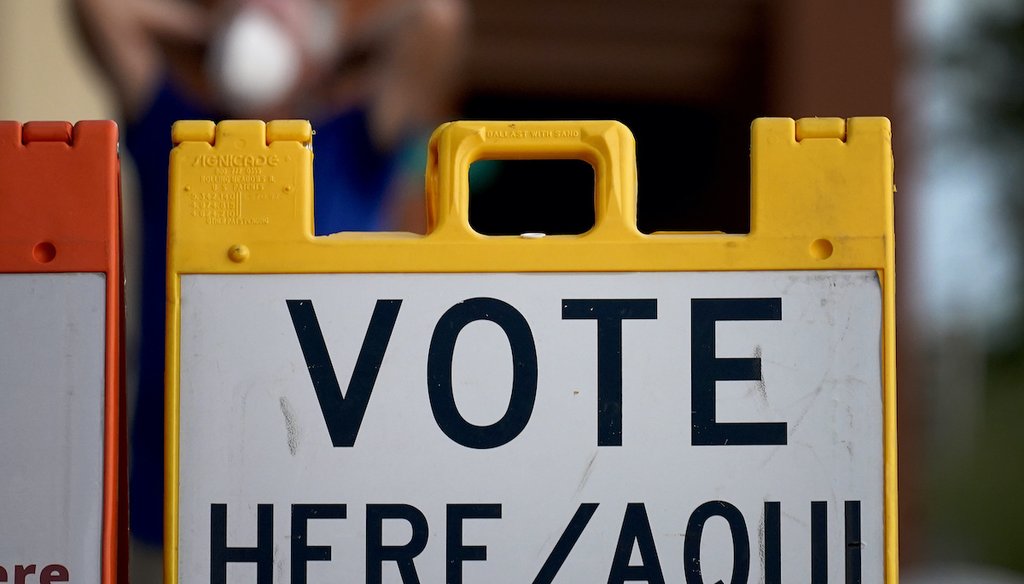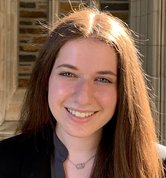Stand up for the facts!
Our only agenda is to publish the truth so you can be an informed participant in democracy.
We need your help.
I would like to contribute

A poll observer stretches outside a polling station on Election Day, early, Tuesday, Nov. 3, 2020, in Glendale, Ariz. (AP)
If Your Time is short
- In many Arizona counties in the Aug. 2 primary, voters will cast ballots at vote centers rather than traditional neighborhood precincts.
-
Vote centers were pioneered by Larimer County in Colorado in 2003 to reduce costs and give voters more convenient choices. Vote centers are now allowed in 18 states as varied politically as Indiana and California.
-
Voting rights advocates and researchers say that vote centers can produce positive benefits such as cost savings, but they must be established correctly and take into account access for minority groups.
When many Arizona voters show up to cast a ballot in the Aug. 2 primary, they will be able to choose from several vote centers rather than one assigned precinct.
Maricopa County officials predict that 10% to 17% of voters will mark their ballots at one of 210 voting centers. The majority of Arizonans will still cast ballots by mail or in person at early voting sites.
Arizona state law has allowed counties to use vote centers entirely or along with assigned polling sites for about a decade. Most Arizonans now live in a county that offers vote centers. Pima County will use vote centers for the first time Aug. 2. St Louis County in Missouri, which introduced vote centers in 2020, will again use them Tuesday.
Voting rights advocates, election officials and academics say there are benefits to breaking away from the traditional precinct model, though it depends on staff, technology and location.
"Vote centers represent a promising election reform that can simultaneously benefit voters and election officials, may boost voter participation, and can reduce the number of voters who lose the opportunity to cast a ballot and have it counted because they show up at the wrong precinct or cannot make it to their own precinct on Election Day," the group All Voting is Local, which advocates for removing discriminatory barriers to voting, said in a 2020 report.
Sign up for PolitiFact texts
The group added that "like any change in voting procedures, a shift to vote centers has the potential to help or to harm some groups of voters."
Not everyone likes the vote center model, but it has drawn far less debate and misinformation than voting by mail.
Scott Doyle, county clerk in Larimer County, Colorado, came up with the idea for vote centers two decades ago.
Doyle told reporters at the time that vote centers would save costs of complying with the federal Help America Vote Act, which required elections officials to replace outdated voting machines. In a traditional precinct model, voters are assigned one site to vote on Election Day. Under a vote center model, voters can go to any site.
In 2003, Larimer scrapped the previous 143 precincts and set up 22 vote centers. In 2004, Colorado passed a bill to allow vote centers.
The concept drew interest from other states, and now 18 states allow jurisdictions to use vote centers on Election Day: Arizona, Arkansas, California, Colorado, Hawaii, Indiana, Iowa (for some elections), Kansas, Kentucky, Nevada, New Mexico, North Dakota, South Dakota, Tennessee, Texas, Utah, Washington and Wyoming. Additional states allow for vote centers during early voting.
Vote centers, also called "vote anywhere" sites, require technology, including printers, that allows any voter in the county to receive an appropriate ballot.
In each election, any county in the U.S. may have hundreds or even thousands of versions of the ballot that voters will cast depending upon their address and party affiliation covering local, state and federal races. Maricopa County alone has more than 19,000 ballot styles for the primary.
Election officials who have successfully implemented vote centers have found benefits
It’s easier to mitigate long lines and other mishaps.: Under a traditional precinct model, if a site had a long line or broken equipment, voters had to wait or return later. Now they can choose another site or look up estimated wait times. Recent flooding in St Louis County, Missouri, prompted some polling sites to close for the Aug. 2 primary, but it shouldn’t affect Election Day operations, said Eric Fey, one of the county’s elections directors. "People can just go to the next one down the street."
Voters no longer show up at the wrong location. With vote centers, voters have more options to try on Election Day; there’s no need for panicked calls to the elections office to find their assigned polling site.
Fewer provisional ballots. Provisional ballots are given to voters when there are questions about their eligibility, including if they’re voting at the wrong site. Vote centers would eliminate the need for provisional ballots for that purpose.
St. Louis County, Missouri, transitioned to vote centers in 2020 to cope with pandemic-related shortages in precincts and poll workers.
The county reduced the number of polling places from 438 in the 2016 general election to 230 in the 2020 general election.
The county saved roughly $80,000 on printing ballots and $20,000 in rental fees paid to polling venues. Even after increasing poll worker pay because of the pandemic, those costs were more than $35,000 lower in 2020 compared with 2016. All told, the 2020 election’s total cost was almost $200,000 less than in 2016, researchers found.
Rice University Professor Robert Stein has published multiple papers on vote centers and found they can increase turnout, particularly among infrequent voters and in elections with lower turnout.
But location is key.
"You open a Walmart and put it in the wrong place — no one is going to go there," Stein said.
In Arizona, some critics of vote centers appear motivated by the false belief that the 2020 election was stolen, a myth debunked by courts and government officials including in former President Donald Trump’s own administration.
Arizona state Rep. Mark Finchem, a Republican running for secretary of state, recently quote-tweeted a conservative activist who was critical of Maricopa’s vote center model. "Bring back precincts," Finchem tweeted. "They are there for a reason." Finchem is part of a national coalition of Republicans that wants nearly everyone to vote in person on Election Day.
All Voting is Local, a voting rights advocacy group, says county officials should analyze whether voters of color or voters with disabilities will be disadvantaged by the location of potential sites and seek feedback from these groups before they pick the sites.
When Maricopa first used vote centers for the presidential preference primary in 2016, it resulted in long lines, sometimes hourslong. After being sued, the county added more vote centers, voting booths and stations to check in voters. The changes succeeded in cutting waits; Votebeat reported that for the 2020 general election, Maricopa County wait times were on average two minutes.
In May, Chinese American and Korean American residents in Los Angeles noticed that there were no planned vote centers in their neighborhoods. Community leaders worked with the government to find spaces that met the requirements, leading them to open three new centers within a span of a few weeks, according to LAist.
RELATED: Poll workers are short-staffed, under attack — and quietly defending democracy
RELATED: All of our fact-checks about Arizona
Our Sources
National Conference of State Legislatures, Vote Centers, Nov. 2, 2021
All Voting is Local, Potential benefits for voters, but standards and protections must be in place, 2020
Maricopa County, August primary election where to vote, 2022
Maricopa County, Election day and emergency voting plan, 2020
Arizona Mirror, Arizona election officials prep for surge in in-person voting during August primary. The state has had mail voting for decades. June 3, 2022
Researchers from the University of Missouri St Louis, Vote at any Polling Place: A Case Study of St. Louis County, Missouri, presented at a conference in July 2022
Robert Stein and Greg Vonnahme, Rice University Engaging the Unengaged Voter: Vote Centers and Voter Turnout, 2008
Robert Stein and Greg Vonnahme, Effects of Election Day Vote Centers on Voter Participation, 2012
David H. Folz, Professor & MPPA Director, Department of Political Science, The University of Tennessee,Vote Centers as a Strategy to Control Election Administration Costs: Findings From a Pilot Project, 2014
Raymond H. Scheele et al, Improving election administration with vote centers: toward a national model, 2009
Wichita Eagle, Vote anywhere? Not anytime soon. Kansas rules frustrate Sedgwick County commissioners, Feb. 17, 2022
Fort Collins Coloradoan, County changes voting system, (Accessed in Nexis) June 29, 2003
Thad Kousser, Eric McGhee and Mindy Romero, Op-Ed: Say goodbye to your local precinct. Voting in California is about to change dramatically, May 31, 2019
Kansas Reflector, Judge dismisses Democrats’ voting lawsuit against SOS Scott Schwab, July 28, 2020
Associated Press, Democrats sue over Kansas delay in start of ‘vote anywhere’, Feb. 14, 2020
Associated Press, Kansas’ new elections chief sparks own voting-rights dispute, Feb. 21, 2020
Kansas State Legislature, S.B. 130, Accessed July 28, 2022
Sierra Vista Herald (Arizona), The right strategy at the right time, (Accessed in Nexis) May 20, 2016
Arizona Republic, Fontes calls primary a 'story of success'; Recorder: 'Significant problems' were resolved by midday, Sept. 21, 2018
Arizona Republic, Here's what election workers say went wrong, (Accessed in Nexis) Sept. 23, 2018
Mindy Romero, Director, Center for Inclusive Democracy, Price School of Public Policy University of Southern California, Voting Location Siting Tool, accessed July 28, 2022
Larimer County, Colorado, History of vote centers, accessed July 28, 2022
LAist, After public outcry, LA County registrar adds 3 vote centers In Koreatown and Chinatown, May 20, 2022
LAist, Lack of polling places in Chinatown and Koreatown decried by Asian American civil rights groups, May 13, 2022
Arizona Secretary of State candidate Mark Finchem, Tweet, July 26, 2022
PolitiFact, Voting by mail has been popular in Arizona for decades. Now the state GOP wants to ban it, March 17, 2022
Email interview, David Kimball, political science professor at University of Missouri-St Louis, July 29, 2022
Telephone interview, Robert Stein, political science professor at Rice University, July 28, 2022
Email interview, Stephen Richer, Maricopa County Recorder, July 28, 2022
Telephone interview, Megan Gilbertson, Maricopa County elections department spokesperson, July 28, 2022
Telephone interview, Eric Fey, Democratic director of elections of St Louis County, Missouri, July 29, 2022
Telephone interview, Tammy Patrick, senior adviser to the elections program at the Democracy Fund and former Maricopa County official, July 28, 2022
Telephone interview, Mindy Romero, Director, Center for Inclusive Democracy, Price School of Public Policy, University of Southern California, July 29, 2022















































